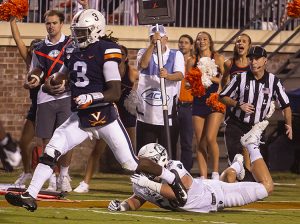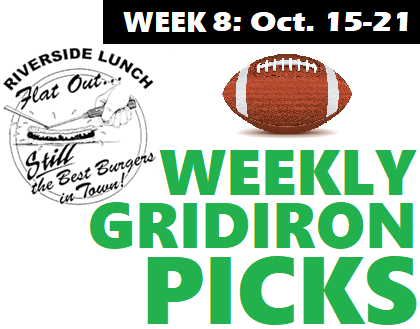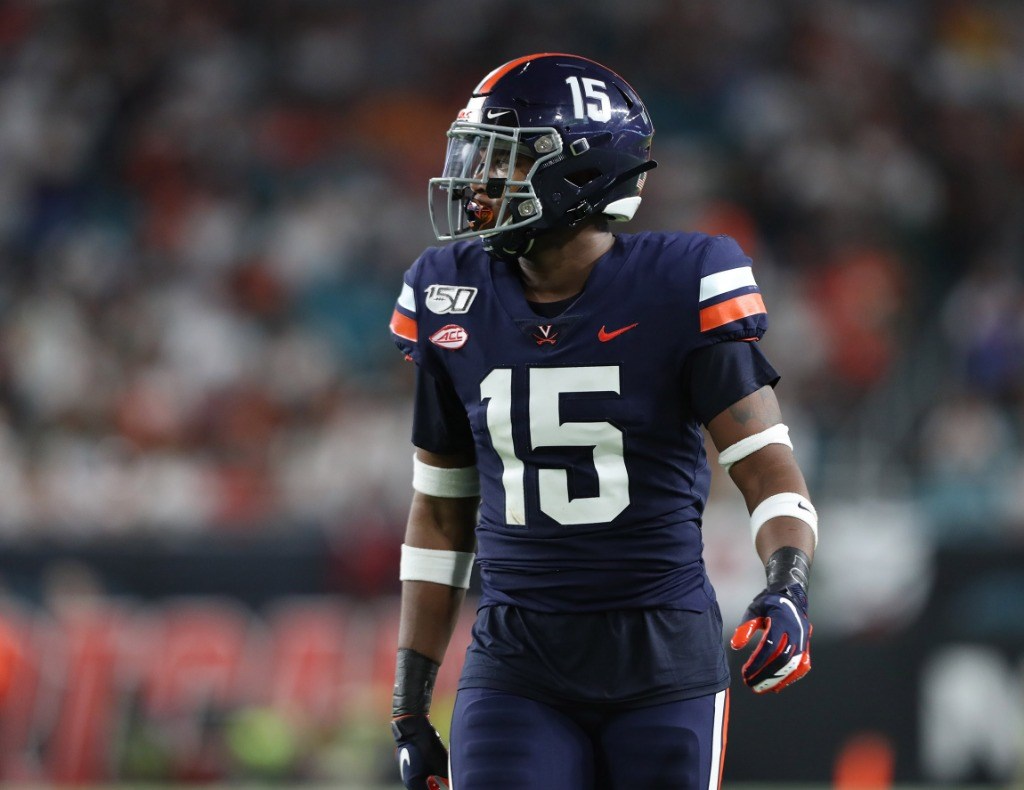By Jerry Ratcliffe

Under Construction. If there were a label that Bronco Mendenhall could place on Virginia’s offensive line, that is what it would read.
While the O-Line has been shaky at best from training camp onward, Mendenhall believes there has been some improvement, though it wasn’t overly evident in the Cavaliers’ 17-9 loss at Miami last Friday night. UVA’s run-blocking and pass-protection woes were exposed at Notre Dame a few weeks ago, and Miami saw the same thing on film as did the Irish.
This week’s opponent, Duke, has already Xeroxed copies of those defensive game plans in preparation of coming to Charlottesville in a battle for first place in the ACC’s Coastal Division standings.
Wahoo fans are wondering that if Virginia couldn’t fix those problems during a bye week between losses to Notre Dame and Miami, how will it solve the issues leading up to Duke?
“It’s ongoing,” Mendenhall said this week of improving his team’s O-line problems. Quarterback Bryce Perkins was sacked 13 times over the last two games (eight vs. the Irish, five vs. the Hurricanes). That ranks Virginia No. 119 in the country out of 130 teams in protecting its quarterback.
“Luckily, Bryce is mobile, he’s active, and his emphasis has been on ball security,” Mendenhall said. “That’s exactly where we are right now.”
Where the Cavaliers are right now is one-dimensional on offense, the last thing any head coach outside of an option-oriented offense wants to hear.
Virginia is No. 123 in the nation in rushing offense, which means defenses can clog up running lanes on obvious running downs and pin their ears back and go after Perkins hard on passing downs. For the past two games, the UVA QB has been under extreme duress, running for his life almost every time he drops back.
“Ongoing work in progress and ongoing group that’s under construction,” Mendenhall said of the O-Line, which consists of three sophomores and two juniors at the starting spots. “It’s an ongoing group that’s being pushed and coached and taught, continual answers being sought.
“While it might not be at the level I would like, I do acknowledge when there is a trend or there is some success or some change happening, yet while it’s not as fast or as strong or as vibrant as I would hope it would be.”
The coach was referring, in part, to allowing only five sacks at Miami, which is much more efficient in that department than Notre Dame, which isn’t known for sacking the quarterback this season.
It’s as simple as cornbread. If you can’t run-block, you can’t run the football, which puts all the pressure on the quarterback to be a more accurate passer under duress or to try and create something on his own, which Perkins often does.
That would explain why Virginia lost at Miami, which was even more inept on offense than the Cavaliers. UVA’s defense controlled that game for the most part, and to give Virginia credit, it managed to move the ball down the field on several drives only to stall out in the Red Zone, which Mendenhall refers to as the Blue Zone (going back to BYU’s blue uniforms, and now UVA’s, only a different shade).
Six trips to the Red, or, er, Blue Zone. Nine points.
Had Virginia mounted any kind of offense down close, it would have walked away from Hard Rock Stadium with a big ol’ ‘W’ in its hip pocket. Instead, the Wahoos are haunted by a two-game losing streak.
Mendenhall expects his teams to score touchdowns at least 50 percent of the time in the Blue Zone.
“Our inefficiency or limited production in the run game is certainly influencing and influenced how Miami played us,” Mendenhall said. “But also give them credit. I think they’re a good defensive team.”
True, the Hurricanes were ranked No. 7 nationally against the run heading into that game, while UVA was ranked No. 116 in rushing offense. That makes sense.
What didn’t make sense was some of the play-calling. On one drive deep into Miami territory, UVA lined up in shotgun and ran the ball up the middle on both third-and-one and fourth-and-one, turning the ball over on downs.
“Our ineffectiveness or inconsistency in running the ball has had some effect, and then concepts that we’ll create a little more space and the ball being delivered where it’s supposed to be and on time with more precision and execution,” the coach said.
“Some of the concepts were really well designed, just not executed at a high enough level. My job is to be ahead of it. In this case I’m after it and reactionary to it, to assess and make the adjustments needed within the limited space (of the Blue Zone), which requires faster timing, more certainty, and a higher level of execution, and we fell short.”
While Perkins may be mobile and can create on his own, perhaps it’s time to give him some more help.
The old pak-yak in football was that the best two ways to slow down an aggressive pass rush is the old-fashioned screen pass (not the wide receivers screens that are so prevalent in today’s game), and the old-fashioned draw play, not always with the quarterback.
Virginia ran one screen pass against Miami and it went for a first down.
I was a fan of the offensive philosophy of the Joe Gibbs (first time around) era in Washington. He came from the Don Coryell coaching tree, which was all about the passing game, but complemented by a strong running game as well.
It was a protection-based offense. I used to cover the Redskins in those days and remember some conversations with both Gibbs and his offensive line coach, Jim Hannifan, who became known as a guru of pass protection.
The whole theory of Gibbs’ system, and it was up to Hannifan to execute it, was he didn’t want to get their quarterback hit. If they needed to keep in five, six, seven, or even eight to block, that’s what they did. Keep in eight, sent two receivers. If that’s what it took, that’s what they did.
If the offensive line isn’t winning its one-on-one battles, which UVA clearly isn’t, the answer was to turn those into two-on-one battles, get extra blockers so that the ones getting beat have a better chance.
Something’s got to give this Saturday against Duke, which is ranked No. 44 in the nation in total defense, No. 48 against the run. There’s no question the Blue Devils will be coming after Perkins, especially if UVA can’t run the ball or slow down the pass rush.
The problem has existed at Virginia for quite a long time. Former quarterback Kurt Benkert, now on injured reserve for the Atlanta Falcons, acknowledged that problem in a tweet this week:
“Most of our Red Zone scoring came from one on one matchups, not by scheme. We also scored more often from taking shots before we got to the Red Zone – so problems were covered up.”
Something to consider.
Virginia is fighting for its life in the Coastal, which it was projected to win in the preseason. Now, with threats from Duke, Carolina, and even Virginia Tech due to a quarterback switch (and non-division foe Louisville), the Cavaliers have little margin for error.


